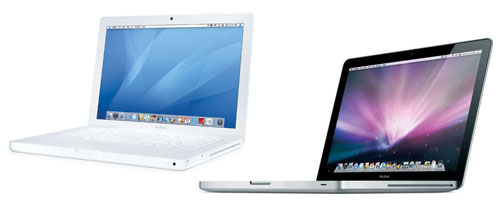Hosted by site sponsor WebMate.
White & Black MacBook Q&A - Published January 24, 2009
To be notified of new Q&As, sign up for EveryMac.com's bimonthly email list.
What are the differences between the "Early 2009 NVIDIA" MacBook Core 2 Duo and the "Late 2008 Unibody" MacBook models?
Please note that the "Early 2009 NVIDIA" MacBook Core 2 Duo was discontinued on May 27, 2009.
Externally, the "Early 2009/NVIDIA" MacBook system -- the MacBook "Core 2 Duo" 2.0 13-Inch (White - Early 2009/NVIDIA) -- is completely different from the "Late 2008/Unibody" MacBook models.
It is worth noting that the "Early 2009/NVIDIA" did not replace the "Unibody" models, but was unexpectedly introduced as a "low end" accompanying system to the "Unibody" series and replaced a largely externally identical "Late 2008" MacBook model that was held over from the previous "Early 2008" line.

Photo Credit: Apple, Inc. (Early 2009 - Left, Late 2008/Unibody - Right)
The "Early 2009/NVIDIA" model uses a white polycarbonate case that weighs 5 pounds, and the "Late 2008/Unibody" series uses a 4.5 pound aluminum black and silver case milled from a single block of aluminum that provides greater strength.
The "Early 2009/NVIDIA" system has a "scrolling Trackpad" with "two-finger click" -- compared to a more advanced "no button" glass "multi-touch" trackpad with support for "four finger" gestures and programmable "zones" on the "Late 2008/Unibody" models. The "Early 2009/NVIDIA" model also does not have an LED-backlit display as the "Late 2008/Unibody" models do, nor does it have a backlit keyboard, like the higher-end MacBook "Core 2 Duo" 2.4 13" (Unibody).
With the exception of external display capability -- the "Late 2008/Unibody" models have a "Mini DisplayPort" which supports an external display at 2560x1600 and the "Early 2009/NVIDIA" models have a mini-DVI port and 1920x1200 support -- connectivity is actually superior on the "low end" model. The "Early 2009/NVIDIA" model has a Firewire "400" port -- and the "Late 2008/Unibody" models do not -- as well as AirPort Extreme (802.11a/b/g/n), Bluetooth 2.1+EDR, Gigabit Ethernet, two USB 2.0 ports, and optical digital/analog audio in/out that are shared by all these systems.
Internally, however, the "Early 2009/NVIDIA" model has much in common with the "Late 2008/Unibody" line -- the MacBook "Core 2 Duo" 2.0 13" (Unibody) in particular -- with the same 45 nm "Penryn" Core 2 Duo processor (P7350), same 1066 MHz system bus, and same NVIDIA GeForce 9400M graphics processor with 256 MB of RAM shared with main memory. Memory, however, is different -- both are equipped by default with 2 GB of RAM -- but the "Early 2009/NVIDIA model uses the older 667 MHz PC2-5300 DDR2 SDRAM standard and the "Late 2008/Unibody" model uses faster 1066 MHz PC3-8500 DDR3 SDRAM.
These differences, as well as configuration differences, are summarized below:
| MacBook 13": | "Early 09" 2.0 (White) | "Late 08" 2.0/2.4 (Unibody) |
|---|---|---|
| Processor: | 2.0 GHz "Core 2 Duo" | 2.0, 2.4 GHz "Core 2 Duo" |
| System Bus: | 1066 MHz | 1066 MHz |
| L2 Cache: | 3 MB | 3 MB |
| Standard RAM: | 2 GB | 2 GB |
| RAM Type: | PC2-5300 DDR2 | PC3-8500 DDR3 |
| Int. Graphics: | NVIDIA GeForce 9400M | NVIDIA GeForce 9400M |
| Shared VRAM: | 256 MB | 256 MB |
| Ext. Display: | 1920x1200 | 2560x1600 |
| Hard Drive: | 120 GB | 160 GB, 250 GB |
| Optical Drive: | 8X DL Write "SuperDrive" | 8X DL Write "SuperDrive" |
| Firewire 400: | Yes | No |
| Display Port: | mini-DVI | Mini DisplayPort |
| LED Display: | No | Yes |
| Backlit KB: | No | No, Yes |
| 4 Finger Keypad: | No | Yes |
| Battery Life: | 4.5 Hours | 5 Hours |
| Weight: | 5.0 lbs (2.27 kg) | 4.5 lbs (2.04 kg) |
| Apple Part No: | MB881LL/A | MB466LL/A, MB467LL/A |
| Original Price: | US$999 | US$1299, US$1599 |
*The 2.0 GHz model does not have a backlit keyboard, the 2.4 GHz model does.
Also see: What are the differences between the "Early 2009 NVIDIA" MacBook Core 2 Duo and the MacBook that it replaced?
Please refer to the Ultimate Mac Comparison feature to dynamically compare any MacBook model to any other G3 or later Mac.
Permalink | Report an Error/Typo | Sign Up for Site Update Notices
<< White & Black MacBook Q&A (Main)
Established in 1996, EveryMac.com has been created by experts with decades of experience with Apple hardware. EveryMac.com includes, and always has included, original research incorporating detailed, hands-on inspection of packaging, computers, and devices as well as extensive real-world use. All information is provided in good faith, but no website or person is perfect. Accordingly, EveryMac.com is provided "as is" without warranty of any kind whatsoever. EveryMac.com, and the authors thereof, shall not be held responsible or liable, under any circumstances, for any damages resulting from the use or inability to use the information within. For complete disclaimer and copyright information please read and understand the Terms of Use and the Privacy Policy before using EveryMac.com. Copying, scraping, or use of any content without expressed permission is not allowed, although links to any page are welcomed and appreciated.
